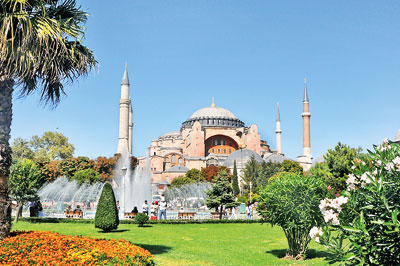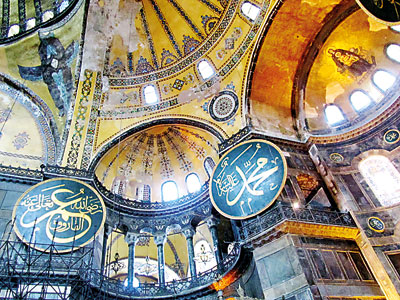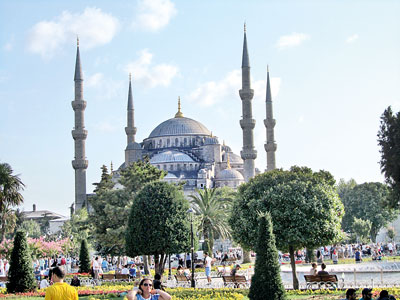Istanbul – Truly a Turkish delight

Ayasofya( Hagia Sophia)
It is a city that straddles two continents, a city so beautiful that Napoleon Bonaparte once observed that if the world were a single country, this city without doubt would be its capital.
And Mustafa Kemal Ataturk, the father of modern Turkey, described it as “ the meeting point of two worlds, the ornament of the Turkish homeland, the treasure of Turkish history and a city cherished by the Turkish nation – the city that has its place in the hearts of all citizens.”
Separated into an European section and an Asian section by the Bosphorus strait that connects the Black Sea to the Mediterranean Sea, modern Istanbul is a city where East literally meets West, where Silk Road merchants came to trade and stayed to settle down, where layers of history unfold as you walk down its ancient streets.
Known at various times in the past as Byzantium and Constantinople (when it was the capital of the Eastern Roman Empire), modern Istanbul contains the architectural creations of its Greek, Roman and Ottoman conquerors. The Christian Byzantines built churches adorned with mosaics and frescoes which their successors, the Muslim Ottomans, embellished into mosques rather than destroyed. Today the silver topped minarets of the old imperial mosques form one of the great skylines of the world.
The Ayasofia or Hagia Sophiais a classic example of the great architectural beauties of the city. Built by the Eastern Roman Emperor Justinian in the sixth century, it was at one time the largest cathedral in the world and the main church of Orthodox Christianity. When the Ottomans under Sultan Mehmet II conquered the city in 1453, one of his first acts was to symbolically enter and pray in the building – which he then embellished and converted into a mosque. It remained an Islamic place of worship until 1931 when President Ataturk ordered it be converted into a museum. No longer a place of worship that is limited to members of a particular faith, Ayasofya today, with its massive dome and beautiful examples of Christian mosaics and Islamic calligraphy, remains one of the world’s finest examples of Byzantine architecture.

Islamic and Christian art co-exist in the Ayasofya
But when you visit Istanbul, don’t limit yourself to visiting just the tourist “must-sees”like the Topkapi palace, the Blue mosque, the ancient cisterns and the Ayasofya museum. Wander around its ancient streets, admiring the elegant Ottoman mansions and the beautiful view across the Bosphorus. Visit the Grand Bazaar or the Spice Market. Stop to sample a delicious pistachio-filled baklava pastry or some genuine lokum (better known as Turkish delight) – and make sure to sip a glass of Cay in a local tea garden (çay bahcesis) or savour typical Türk kahvesi in one Istanbul’s many kahvehanı (coffee houses).
And of course, make sure you leave plenty of time to savour some of Istanbul’s food. Just as in Sri Lanka, where the many races that have lived on this island have left their influence on our food, so too it is in Turkey. Just to suggest a few examples of snacks to savour, try savoury borek (stuffed pastries), gozleme (like gothambe roti), balik ekmek (fish sandwiches) and kofte (spiced ground meatballs).
Just writing about these delicious foods makes my mouth water!

The Blue Mosque


